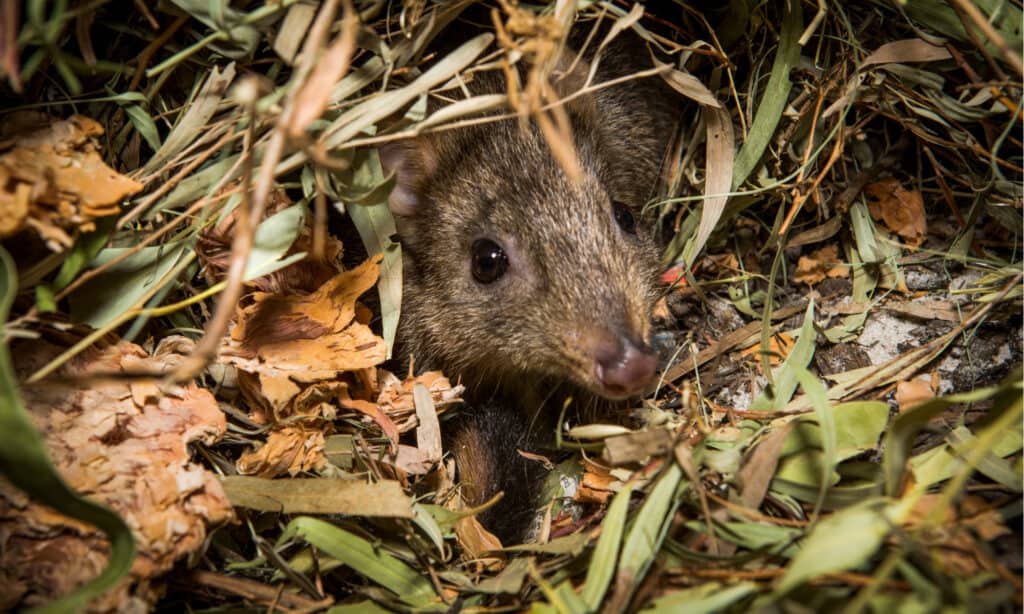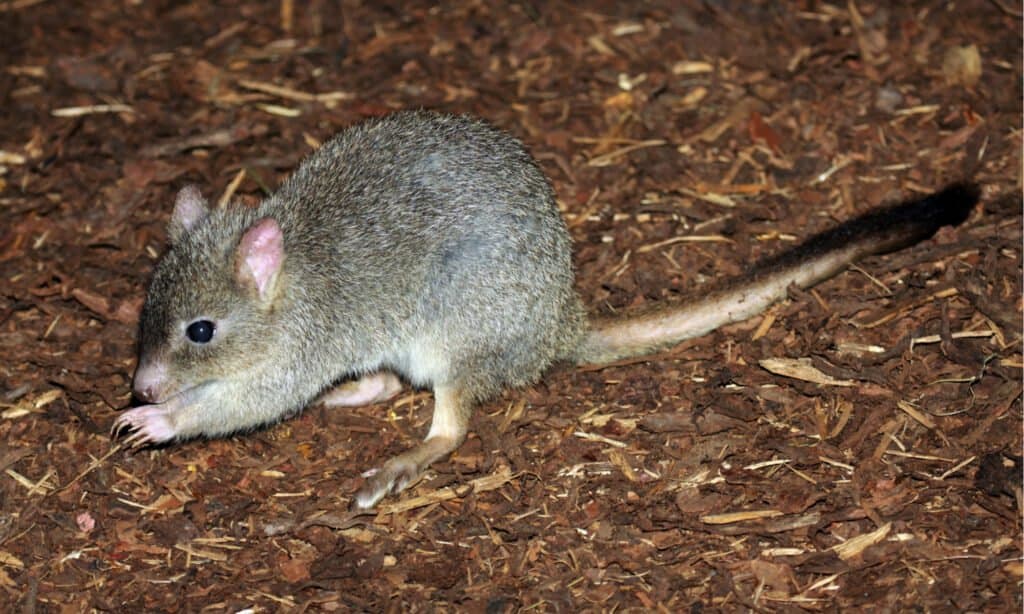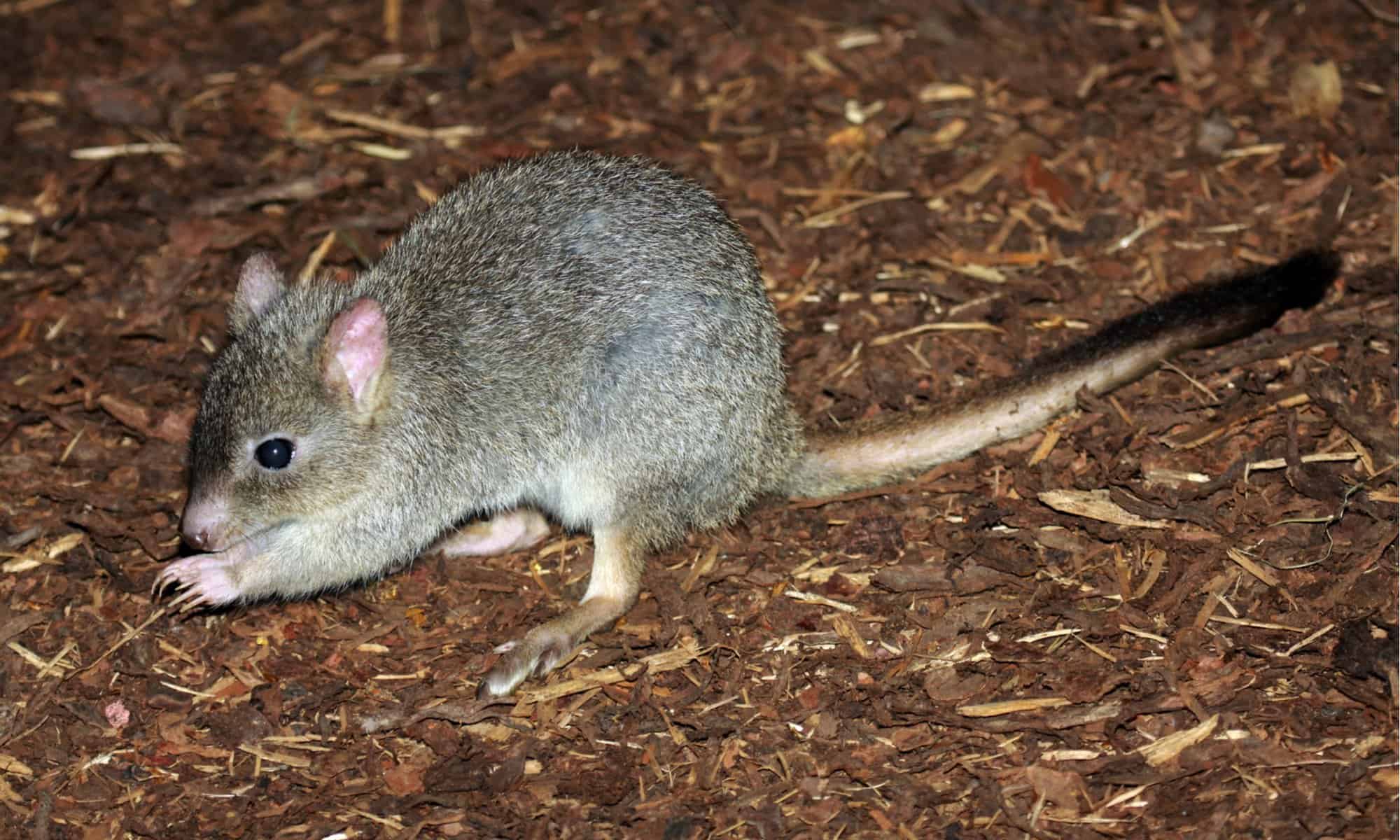A woylie is a marsupial that’s endemic to Australia, which means you can only find them there. Their scientific name is Bettongia penicillata ogilbyi, and they are one of two subspecies of Bettongia penicillata. The other species, Bettongia penicillata penicillata, was listed as extinct by the 1920s.
These creatures were once abundant on their native island but are now considered critically endangered. They are a part of the Potoridae family which means they are related to other native Australian animals like wallabies and kangaroo rats.
These marsupials have prehensile tails that can coil up similar to possums. Their tails act as a ‘fifth limb’ that they use to transfer materials to nesting sites. They also have a marsupium which is a pouch used for carrying babies that marsupials like kangaroos and woylies have. Because there are so few woylies, it’s no surprise not many people know what they eat. Let’s talk about the woylie’s diet.
Where Do Woylies Live?
Until around the 1980s, woylies were an abundant species that inhabited around 60% of the Australian mainland. Woylies are animals that are native to Australia. While this species was thriving, they preferred desert grasslands and forests, but n,o they are only found in forests, woodlands, and eucalyptus scrublands.
Because this species is endangered, they are now only found in a few nature reserves like Perup Nature Reserve, Tutanning Nature Reserve, and Dryandra Woodland found in the southwest area of the country. Their species decline started when European settlers came and cleared large areas of land and destroyed their home. After they cleared the land, they captured millions of woylies and skinned them for their fur.
What Do Woylies Eat?

Adult woylies grow to about 25 to 48 cm in length. They are small enough to fit in your hand. What does a creature so small eat? These bettongs are omnivores. They eat a diet consisting of;
- Fungi
- rubber roots
- bulbs
- seeds
- plant material
- invertebrates
- truffles
They don’t drink water and tend not to include very much green vegetation in their diet because they get all the necessary hydration from the foods they eat.
The woylie is nocturnal, so they spend their nights foraging. These marsupials are solitary animals known to be aggressive when it comes to their nesting and mating grounds. Though their feedings ground often overlaps, they also get defensive when encountering others while looking for food.
What Do Baby Woylies Eat?
Female woylies have around 2 or 3 young a year. The babies will emerge underdeveloped at just 21 days of gestation. They will then crawl into the mother pouch, where they will remain for about 90 days.
During the time they are in their mother’s pouch, they will have a diet consisting only of milk. This will continue even after they’re kicked out of their pouch for a new baby up until that new baby leaves the pouch.
How Much Does A Woylie Eat?

©GPT Photography/Shutterstock.com
The amount of food a Woylie eats changes with the seasons. A study in the Australian Journal of Zoology showed that woylies consume more quantities and types of fungi in the autumn and winter than they do in summer and spring. They eat far more plants, fruits, and invertebrates in the dryer months of summer and spring. They found woylies eat a larger, more rich variety of fungi during spring and winter than summer and autumn.
What Eats A Woylie?
Woylies are small creatures that live in nests they build from woodland and forest debris. When they feel threatened, they will hide in their nest until the last second and try to flee. This makes them easy prey for stealthy predators like foxes and feral cats.
Woylies have three main predators. They are feral cats, European red foxes, and dogs The cat is their main predator since the attempt to control fox populations to try and stabilize woylie populations. Once the fox population was controlled, wildlife researchers noticed feral cats are a previously unknown major threat to the woylie. Cats were causing 65% of woylie mortalities during a study done from 2006 to 2009.
How Are Woylies Beneficial To Their Environment?
Some of the woylie’s diet is found underground. Their noses allow them to detect food underground, and their front claws are designed to dig up what they find easily. These underground fungi are truffles, and they are the main component in a woylies diet. They provide all the nutrients they need.
Woylies are very beneficial for the environment. Their foraging turns the soil and spreads fungi spores and seeds. This is very beneficial for the health of woodland ecosystems where these marsupials make their homes.
Why Are Woylies Endangered?

The woylie has been considered critically endangered since 2008 when wildlife researchers noticed a 90% decline in population size. Their population decrease is caused by four factors. These are;
- Predation
- Human Influence
- Habitat Destruction
- Disease
Despite targeted population management and research efforts, one of the main causes for the decline of the woylie species is introduced predators like the European red fox and the feral cat. Woylies used to be considered pests because of the damage they would do to garden produce, so in some areas of Australia, feral cats were explicitly introduced to exterminate them.
Human influence is another factor that may be affecting woylie populations. It comes from human actions like eco-tourism and hand-feeding wild animals, and these things disrupt natural wildlife and are closely linked to disease outbreaks in animals. Diseases are one if not the main reason for major population decline in woylies. There are a number of diseases common amongst woylies that are thought to be causing the recent large declines in population.
Long-term habitat destruction has caused a negative impact on the woylie populations over multiple decades. This destruction is caused by a number of things like;
- Pigs
- Clearing and grazing of private, state forest, and pastoral areas.
- Climate change.
The destruction of the woylies’ habitat leads to a scarcity of feeding grounds, nesting areas, and mating grounds. This has been causing a fast decline in populations in the past few years.
Thank you for reading! Have some feedback for us? Contact the AZ Animals editorial team.








